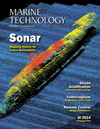
Human Powered Subs
Twelve teams from universities in six countries on three continents are scheduled to meet in July 2014 to take part in the second biennial European International Submarine Races (eISR) at QinetiQ’s Ocean Basin in Gosport, U.K., the biggest covered water space in Europe.
This week-long event from July 7-11, 2014, is a unique sporting and engineering challenge which tests the students’ engineering skills. Every human powered submarine taking part is designed and built by each individual university, with vital amendments and adjustments and even rebuilding taking place during the week. It also tests sporting prow and stamina as the teams race against the clock with the pilot wearing SCUBA gear and pedaling underwater around a demanding slalom course in the tank measuring 122 x 61m and 5.5m deep.
Teams competing for the 2014 awards are: École Polytechnique de Montréal, École de Technologie Supérieure and University of British Columbia all from Canada; Rhine Waal University of Applied Sciences from Germany; University of Delft from the Netherlands; University of Auckland from New Zealand; University of Michigan and University of Washington from the USA; and four teams from the UK with University of Bath, University of Plymouth, University of Southampton, and University of Warwick.
“There were just six teams at our inaugural races in 2012, so it is highly rewarding to see a dozen (our top limit) registered already, with three more universities on the waiting list in case of any last minute dropouts,” said Race Director, Prof William Megill, FIMarEST.
“Naturally, we want the members of our teams to have a highly enjoyable week at the races and our networking events will help them do that; but they know only too well that the overall objective of the eISR is to encourage innovative design in submarine engineering,” said Megill. “Past teams, comprised of multi-disciplinary engineering students, have designed a wide variety of exciting machines, propelled either by standard rotating propellers, or by novel non-propeller thrusters.
“Regardless of the propulsion system selected, the basic design and build process boils down to five components: hull, propulsion, transmission, pilot safety and ergonomics, and control. The levels of sophistication applied to all of these components are up to each team - it is possible to do well with just a hull, some fins, and a recycled bicycle, but to really excel requires some serious thought and careful manufacturing, and of course, the submarine must be finished and functioning for that all-important week in July.”
The eISR is organized by the Institute of Marine Engineering, Science and Technology in partnership with QinetiQ; and the eminent judging panel is headed by Vice Admiral Sir Robert Hill, KBE, FIMarEST.
www.subrace.eu
(As published in the MARCH 2014 edition of Marine Technology Reporter - www.seadiscovery.com)
Read Human Powered Subs in Pdf, Flash or Html5 edition of March 2014 Marine Technology
Other stories from March 2014 issue
Content
- Europe’s Seas Under Threat page: 12
- Human Powered Subs page: 14
- UK North Sea Activity Report page: 16
- Bibby Offshore Invests in Fleet page: 18
- CSS Olympia Delivered to GranEnergia page: 18
- Blyth Workcat Joins Osiris Projects Survey Fleet page: 20
- Sonar & the USCG page: 22
- Five Minutes with Hydroid President Duane Fotheringham page: 26
- Advances in Robotic Vehicle Technology page: 32
- There’s an App for That! page: 38
- Expect the Unexpected: Acidic Oceans page: 44
- X (Prize) Marks the Spot page: 52
- D-Day Mapping Mission page: 56
- 3D Imagining: Real-time with SAS page: 62
- I can see clearly now ... Via Resolution Optics page: 66
- New MASK Unveiled page: 72
- Interview: Global Diving & Salvage CEO Devon Grennan page: 76
- MacArtney's Record Growth in North America page: 83
- OI 2014 Technology Preview page: 84
- Sonar Image Stabilization A Powerful Tool page: 88
- Scanning Sonar for Search and Survey page: 88
- LiDAR Ordered for Wind Farm Development page: 88
- New Compact in situ pCO2 Sensor page: 89
- BIRNS Millennium Connectors page: 89
- New Survey Interface page: 89
- Engineered Syntactic Systems Expands Buoyancy Offering page: 90
- Sonardyne Ranger 2 Chosen for Russian Salvage Vessel page: 90
- New Broco Underwater Cutting Rod page: 90
- Shark Marine Launches D.A.S. Boat page: 91
- Kongsberg Camera Systems for OOI page: 91


